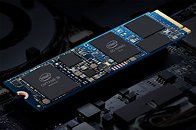Wednesday, April 10th 2019

Intel Packs 3D X-Point and QLC NAND Flash Into a Single SSD: Optane H10
Intel today revealed details about Intel Optane memory H10 with solid-state storage - an innovative device that combines the superior responsiveness of Intel Optane technology with the storage capacity of Intel Quad Level Cell (QLC) 3D NAND technology in a single space-saver M.2 form factor. "Intel Optane memory H10 with solid-state storage features the unique combination of Intel Optane technology and Intel QLC 3D NAND - exemplifying our disruptive approach to memory and storage that unleashes the full power of Intel-connected platforms in a way no else can provide," said Rob Crooke, Intel senior vice president and general manager of the Non-Volatile Memory Solutions Group.
Combining Intel Optane technology with Intel QLC 3D NAND technology on a single M.2 module enables Intel Optane memory expansion into thin and light notebooks and certain space-constrained desktop form factors - such as all-in-one PCs and mini PCs. The new product also offers a higher level of performance not met by traditional Triple Level Cell (TLC) 3D NAND SSDs today and eliminates the need for a secondary storage device.Intel's leadership in computing infrastructure and design allows the company to utilize the value of the platform in its entirety (software, chipset, processor, memory and storage) and deliver that value to the customer. The combination of high-speed acceleration and large SSD storage capacity on a single drive will benefit everyday computer users, whether they use their systems to create, game or work. Compared to a standalone TLC 3D NAND SSD system, Intel Optane memory H10 with solid-state storage enables both faster access to frequently used applications and files and better responsiveness with background activity.
8th Generation Intel Core U-series mobile platforms featuring Intel Optane memory H10 with solid state storage will be arriving through major OEMs starting this quarter. With these platforms, everyday users will be able to:
The Intel Optane memory H10 with solid-state storage will come in the following capacities, 16GB (Intel Optane memory) + 256GB (storage); 32GB (Intel Optane memory) + 512GB (storage); and 32GB (Intel Optane memory) + 1TB storage.
For more information, visit this page.
Combining Intel Optane technology with Intel QLC 3D NAND technology on a single M.2 module enables Intel Optane memory expansion into thin and light notebooks and certain space-constrained desktop form factors - such as all-in-one PCs and mini PCs. The new product also offers a higher level of performance not met by traditional Triple Level Cell (TLC) 3D NAND SSDs today and eliminates the need for a secondary storage device.Intel's leadership in computing infrastructure and design allows the company to utilize the value of the platform in its entirety (software, chipset, processor, memory and storage) and deliver that value to the customer. The combination of high-speed acceleration and large SSD storage capacity on a single drive will benefit everyday computer users, whether they use their systems to create, game or work. Compared to a standalone TLC 3D NAND SSD system, Intel Optane memory H10 with solid-state storage enables both faster access to frequently used applications and files and better responsiveness with background activity.
8th Generation Intel Core U-series mobile platforms featuring Intel Optane memory H10 with solid state storage will be arriving through major OEMs starting this quarter. With these platforms, everyday users will be able to:
- Launch documents up to 2 times faster while multitasking.
- Launch games 60% faster while multitasking.
- Open media files up to 90% faster while multitasking.
The Intel Optane memory H10 with solid-state storage will come in the following capacities, 16GB (Intel Optane memory) + 256GB (storage); 32GB (Intel Optane memory) + 512GB (storage); and 32GB (Intel Optane memory) + 1TB storage.
For more information, visit this page.

31 Comments on Intel Packs 3D X-Point and QLC NAND Flash Into a Single SSD: Optane H10
Source: www.anandtech.com/show/14196/intel-releases-optane-memory-h10-specifications
Is it that hard to replace SSD controller RAM buffer with 32GB x-point and have cheap ultra-fast 1TB SSD?
So, this is what we would all want (as using RST means you're platform locked and stuck with half the interface speed for your SSD), it'll be a while until we see it - and it won't be cheap when we do.
Looks like nobody wants QLC so they had to come up with something to push some sales.
What are the densities for IMFTs 3D Xpoints anyway(Or micron now-a-days)? I presume Optane 800p uses the highest density chips, it being single sided I presume those two are 64GB chips. Am I right or is there some PoP -chip packaging going on?
ark.intel.com/content/www/us/en/ark/products/148607/intel-optane-ssd-905p-series-380gb-m-2-110mm-pcie-x4-20nm-3d-xpoint.html
This has 7 XPoint chips on it so looks like they are only (mass) producing 64GB dies at this time.
As for enabling it on budget boards - all Intel chipset in the same generation are the same silicon with parts disabled as you go down the range. Which means that if one part has this capability, they all do.
As for you for some reason mentioning AMD chipsets: while it's embarrassingly obvious that Intel has no power to enable or disable features in those, AMD already supports PCIe bifurcation on their consumer platforms (though from the CPU as they don't provide much PCIe through their chipsets). Go figure.
It is Intel.
Remember when Ryzen came out, how quickly they launch the 8000 series CPU ?
PLX chips are switches, this thing doesn't need one.
Magic will happen when they combine the two on one chip and make it X8.
AMD also does not support bifurcation on consumer platforms. B350/450 comes to mind.
PLX are switches, this is doing 4 > 2x2 and does not need one. Clock buffer it might need, depending on how both these drives and motherboards are built.
Interesting though, how would these drives show up in non-Intel board or are these functional enough without special software like RST?